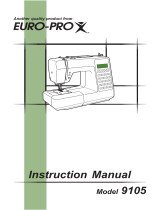
3
CONTENTS
1. KNOWING YOUR SEWING MACHINE ..........................................................5
NAMES OF MACHINE PARTS AND THEIR FUNCTIONS ....................................................5
The main parts ................................................................................................................................................. 5
Needle and presser foot section ...................................................................................................................... 6
Operation buttons ............................................................................................................................................. 6
Operation panel ................................................................................................................................................ 7
Flat bed attachment ......................................................................................................................................... 7
ACCESSORIES .....................................................................................................................8
Optional accessories ........................................................................................................................................ 8
USING YOUR SEWING MACHINE .....................................................................................9
Power supply precautions ................................................................................................................................ 9
Power supply .................................................................................................................................................... 9
Foot controller ................................................................................................................................................ 10
Sewing speed controller (for models equipped with the start/stop button) ..................................................... 10
Changing the needle stop position ................................................................................................................. 10
THREADING THE MACHINE ............................................................................................11
Winding the bobbin ........................................................................................................................................ 11
Lower threading ............................................................................................................................................. 14
Upper threading ............................................................................................................................................. 16
Drawing up the lower thread .......................................................................................................................... 19
REPLACING THE NEEDLE .................................................................................................20
Needle precautions ........................................................................................................................................ 20
Needle types and their uses ........................................................................................................................... 20
Checking the needle ...................................................................................................................................... 21
Replacing the needle ..................................................................................................................................... 21
Sewing with a twin needle .............................................................................................................................. 23
REPLACING THE PRESSER FOOT ......................................................................................24
Replacing the presser foot ............................................................................................................................. 24
Removing the presser foot holder .................................................................................................................. 25
2. SEWING BASICS ...........................................................................................26
SEWING ............................................................................................................................26
General sewing procedure ............................................................................................................................. 26
Selecting stitching .......................................................................................................................................... 27
Starting to sew ............................................................................................................................................... 28
Thread tension ............................................................................................................................................... 29
USEFUL SEWING TIPS ......................................................................................................30
Trial sewing .................................................................................................................................................... 30
Changing the sewing direction ....................................................................................................................... 30
Sewing curves ................................................................................................................................................ 30
Sewing thick fabrics ....................................................................................................................................... 30
Sewing thin fabrics ......................................................................................................................................... 31
Sewing stretch fabrics .................................................................................................................................... 31
Using a free-arm style .................................................................................................................................... 31






















